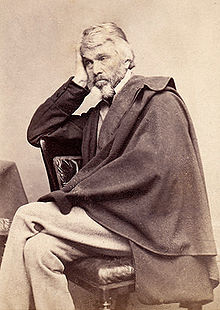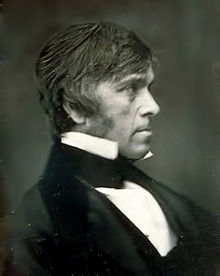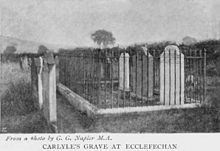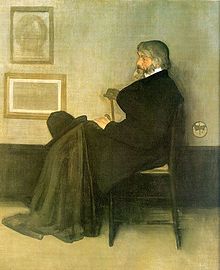- Thomas Carlyle
-
Thomas Carlyle 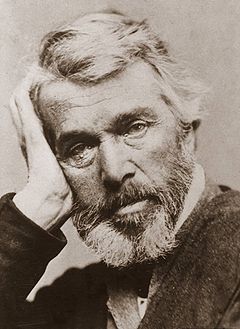
Photo by Elliott & Fry circa 1860sBorn 4 December 1795
Ecclefechan, Dumfries and Galloway, Scotland1Died 5 February 1881 (aged 85)
London, EnglandOccupation Essayist, satirist, historian Literary movement Victorian literature, Romanticism Thomas Carlyle (4 December 1795 – 5 February 1881) was a Scottish satirical writer, essayist, historian and teacher during the Victorian era.[1] He called economics "the dismal science", wrote articles for the Edinburgh Encyclopedia, and became a controversial social commentator.[1]
Coming from a strict Calvinist family, Carlyle was expected to become a preacher by his parents, but while at the University of Edinburgh, he lost his Christian faith. Calvinist values, however, remained with him throughout his life. This combination, of a religious temperament with loss of faith in traditional Christianity, made Carlyle's work appealing to many Victorians who were grappling with scientific and political changes that threatened the traditional social order.
Contents
Early life and influences
Carlyle was born in Ecclefechan, Dumfries and Galloway,.[1] His parents determinedly afforded him an education at Annan Academy, Annan, where he was bullied and tormented so much that he left after three years.[2] In early life, his family's (and his nation's) strong Calvinist beliefs powerfully influenced the young man.
After attending the University of Edinburgh, Carlyle became a mathematics teacher,[1] first in Annan and then in Kirkcaldy, where Carlyle became close friends with the mystic Edward Irving. (Confusingly, there is another Scottish Thomas Carlyle, born a few years later and also connected to Irving, through his work with the Catholic Apostolic Church.[3])
In 1819–1821, Carlyle returned to the University of Edinburgh, where he suffered an intense crisis of faith and conversion that would provide the material for Sartor Resartus ("The Tailor Retailored"), which first brought him to the public's notice.
Carlyle developed a painful stomach ailment, possibly gastric ulcers (which pseudo-medicine of the time attributed to this "crisis of faith"[4]), that remained throughout his life and contributed to his reputation as a crotchety, argumentative, and somewhat disagreeable personality.
His prose style, famously cranky and occasionally savage, helped cement a reputation of irascibility.[5]
He began reading deeply in German literature.[1] Carlyle's thinking was heavily influenced by German Idealism, in particular the work of Johann Gottlieb Fichte. He established himself as an expert on German literature in a series of essays for Fraser's Magazine, and by translating German writers, notably Goethe (the novel Wilhelm Meisters Lehrjahre).[1] He also wrote Life of Schiller (1825).[1]
In 1826, Thomas Carlyle married Jane Baillie Welsh, herself a writer, whom he had met in 1821,[1] during his period of German studies.
His home in residence for much of his early life, after 1828, was a farm in Craigenputtock, a house in Dumfrieshire, Scotland where he wrote many of his works.[1] He often wrote about his life at Craigenputtock, "It is certain that for living and thinking in I have never since found in the world a place so favourable.... How blessed, might poor mortals be in the straitest circumstances if their wisdom and fidelity to heaven and to one another were adequately great!".
At the Craigenputtock farm, Carlyle also wrote some of his most distinguished essays, and he began a lifelong friendship with the American essayist Ralph Waldo Emerson.[1] In 1834, Carlyle moved to the Chelsea, London section of London, where he was then known as the "Sage of Chelsea" and became a member of a literary circle which included the essayists Leigh Hunt and John Stuart Mill.[1]
In London, Carlyle wrote The French Revolution: A History (3 volumes, 1837), as a historical study concerning oppression of the poor, which was immediately successful. That was the start of many other writings in London.
Writings
Early writings
By 1821, Carlyle had abandoned the clergy as a career and focused on making a life as a writer. His first attempt at fiction was "Cruthers and Jonson", one of several abortive attempts at writing a novel. Following his work on a translation of Goethe's Wilhelm Meister's Apprenticeship,[1] he came to distrust the form of the realistic novel and so worked on developing a new form of fiction. In addition to his essays on German literature, he branched out into wider ranging commentary on modern culture in his influential essays Signs of the Times and Characteristics.
Sartor Resartus
His first major work, Sartor Resartus ("The Tailor Retailored") was begun in 1831 at his home (provided for him by his wife Jane Welsh, from her estate), Craigenputtock,[1] and was intended to be a new kind of book: simultaneously factual and fictional, serious and satirical, speculative and historical. It ironically commented on its own formal structure, while forcing the reader to confront the problem of where 'truth' is to be found. Sartor Resartus was first published periodically in Fraser's Magazine from 1833 to 1834.[1] The text presents itself as an unnamed editor's attempt to introduce the British public to Diogenes Teufelsdröckh, a German philosopher of clothes, who is in fact a fictional creation of Carlyle's. The Editor is struck with admiration, but for the most part is confounded by Teufelsdröckh's outlandish philosophy, of which the Editor translates choice selections. To try to make sense of Teufelsdröckh's philosophy, the Editor tries to piece together a biography, but with limited success. Underneath the German philosopher's seemingly ridiculous statements, there are mordant attacks on Utilitarianism and the commercialization of British society. The fragmentary biography of Teufelsdröckh that the Editor recovers from a chaotic mass of documents reveals the philosopher's spiritual journey. He develops a contempt for the corrupt condition of modern life. He contemplates the "Everlasting No" of refusal, comes to the "Centre of Indifference", and eventually embraces the "Everlasting Yea". This voyage from denial to disengagement to volition would later be described as part of the existentialist awakening.
Given the enigmatic nature of Sartor Resartus, it is not surprising[citation needed] that it was first received with little success. Its popularity developed over the next few years, and it was published in book form in Boston 1836, with a preface by Ralph Waldo Emerson, influencing the development of New England Transcendentalism. The first English edition followed in 1838.
The French Revolution
In 1834, Carlyle moved to London from Craigenputtock and began to move among celebrated company.[1] Within the United Kingdom, Carlyle's success was assured by the publication of his three-volume work The French Revolution: A History in 1837.[1] After the completed manuscript of the first volume was accidentally burned by the philosopher John Stuart Mill's maid, Carlyle wrote the second and third volumes before rewriting the first from scratch.[2][4]
The resulting work was filled with a passionate intensity, hitherto unknown in historical writing. In a politically charged Europe, filled with fears and hopes of revolution, Carlyle's account of the motivations and urges that inspired the events in France seemed powerfully relevant. Carlyle's style of writing emphasised this, continually stressing the immediacy of the action – often using the present tense.
For Carlyle, chaotic events demanded what he called 'heroes' to take control over the competing forces erupting within society. While not denying the importance of economic and practical explanations for events, he saw these forces as 'spiritual' – the hopes and aspirations of people that took the form of ideas, and were often ossified into ideologies ("formulas" or "isms", as he called them). In Carlyle's view, only dynamic individuals could master events and direct these spiritual energies effectively: as soon as ideological 'formulas' replaced heroic human action, society became dehumanised.
On a side note, Victorian writer Charles Dickens used Carlyle's work as a primary source for the events of the French Revolution in his novel A Tale of Two Cities.
Heroes and Hero Worship
These ideas were influential on the development of Socialism, but—like the opinions of many deep thinkers of the time—are also considered to have influenced the rise of Fascism.[6] Carlyle moved towards his later thinking during the 1840s, leading to a break with many old friends and allies, such as Mill and, to a lesser extent, Emerson. His belief in the importance of heroic leadership found form in his book "On Heroes, Hero-Worship, and the Heroic in History", in which he compared a wide range of different types of heroes, including Odin, Oliver Cromwell, Napoleon, William Shakespeare, Dante, Samuel Johnson, Jean-Jacques Rousseau, Robert Burns, John Knox, Martin Luther and the Prophet Muhammad.
The book was based on a course of lectures he had given. The French Revolution had brought Carlyle fame, but little money. His friends worked to set him on his feet by organizing courses of public lectures for him, drumming up an audience and selling guinea tickets. Between 1837 and 1840, Carlyle delivered four such courses. The final course was on "Heroes." From the notes he had prepared for this course, he wrote out his book, reproducing the curious effects of the spoken discourses.[7]
The Hero as Man of Letters (Quotes):
- "In books lies the soul of the whole Past Time; the articulate audible voice of the Past, when the body and material substance of it has altogether vanished like a dream."
- "A man lives by believing something; not by debating and arguing about many things."
- "All that mankind has done, thought, gained or been: it is lying as in magic preservation in the pages of books."
- "What we become depends on what we read after all of the professors have finished with us. The greatest university of all is a collection of books."
- "The suffering man ought really to consume his own smoke; there is no good in emitting smoke till you have made it into fire."
- "Adversity is sometimes hard upon a man; but for one man who can stand prosperity, there are a hundred that will stand adversity." (Often shortened to "can't stand prosperity" as an unknown quote.)
- "Not what I have, but what I do, is my kingdom."
Carlyle was one of the very few philosophers who witnessed the industrial revolution but still kept a transcendental non-materialistic view of the world. The book included people ranging from the field of Religion through to literature and politics. He included people as coordinates and accorded Muhammad a special place in the book under the chapter title "Hero as a Prophet". In his work, Carlyle declared his admiration with a passionate championship of Muhammad as a Hegelian agent of reform, insisting on his sincerity and commenting 'how one man single-handedly, could weld warring tribes and wandering Bedouins into a most powerful and civilized nation in less than two decades.' For Carlyle, the hero was somewhat similar to Aristotle's "Magnanimous" man — a person who flourished in the fullest sense. However, for Carlyle, unlike Aristotle, the world was filled with contradictions with which the hero had to deal. All heroes will be flawed. Their heroism lay in their creative energy in the face of these difficulties, not in their moral perfection. To sneer at such a person for their failings is the philosophy of those who seek comfort in the conventional. Carlyle called this 'valetism', from the expression 'no man is a hero to his valet.[8]
All these books were influential in their day, especially on writers such as Charles Dickens and John Ruskin. However, after the Revolutions of 1848 and political agitations in the United Kingdom, Carlyle published a collection of essays entitled "Latter-Day Pamphlets" (1850) in which he attacked democracy as an absurd social ideal, while equally condemning hereditary aristocratic leadership. Two of these essays, No. I: "The Present Times" and No. II: "Model Prisons" were reviewed by Karl Marx and Fredereick Engels in April 1850.[9] Carlyle criticized hereditary aristocratic leadership as "deadening," however, he criticized democracy as nonsensical: as though truth could be discovered by totting up votes. Government should come from those most able. But how we were to recognise the ablest, and to follow their lead, was something Carlyle could not clearly say. Marx and Engels agreed with Carlyle as far as his criticism of the hereditary aristocracy. However they criticized Carlyle's plan to use democracy to find the "Noblest" and the other "Nobles" that are to form the government by the "ablest" persons.[10]
In later writings, Carlyle sought to examine instances of heroic leadership in history. The Letters and Speeches of Oliver Cromwell (1845) presented a positive image of Cromwell: someone who attempted to weld order from the conflicting forces of reform in his own day. Carlyle sought to make Cromwell's words live in their own terms by quoting him directly, and then commenting on the significance of these words in the troubled context of the time. Again this was intended to make the 'past' 'present' to his readers.
The Everlasting Yea and No
The Everlasting Yea is Carlyle's name for the spirit of faith in God in an express attitude of clear, resolute, steady, and uncompromising antagonism to the Everlasting No, and the principle that there is no such thing as faith in God except in such antagonism against the spirit opposed to God.[11]
The Everlasting No is Carlyle's name for the spirit of unbelief in God, especially as it manifested itself in his own, or rather Teufelsdröckh's, warfare against it; the spirit, which, as embodied in the Mephistopheles of Goethe, is for ever denying,—der stets verneint—the reality of the divine in the thoughts, the character, and the life of humanity, and has a malicious pleasure in scoffing at everything high and noble as hollow and void.
In Sartor Resartus, the narrator moves from the "Everlasting No" to the "Everlasting Yea," but only through "The Center of Indifference," which is a position not merely of agnosticism, but also of detachment. Only after reducing desires and certainty and aiming at a Buddha-like "indifference" can the narrator move toward an affirmation. In some ways, this is similar to the contemporary philosopher Søren Kierkegaard's "leap of faith" in Concluding Unscientific Postscript.
In regards to the abovementioned "antagonism," one might note that William Blake famously wrote that "without contraries is no progression," and Carlyle's progress from the everlasting nay to the everlasting yea was not to be found in the "Centre of Indifference" (as he called it) but in Natural Supernaturalism, a Transcendental philosophy of the divine within the everyday.[original research?]
Worship of Silence and Sorrow
Based on Goethe's having described Christianity as the "Worship of Sorrow", and "our highest religion, for the Son of Man", Carlyle adds, interpreting this, "there is no noble crown, well worn or even ill worn, but is a crown of thorns".
The "Worship of Silence" is Carlyle's name for the sacred respect for restraint in speech till "thought has silently matured itself, …to hold one's tongue till some meaning lie behind to set it wagging," a doctrine which many misunderstand, almost wilfully, it would seem; silence being to him the very womb out of which all great things are born.
Frederick the Great
His last major work was the epic life of Frederick the Great (1858–1865). In this Carlyle tried to show how a heroic leader can forge a state, and help create a new moral culture for a nation. For Carlyle, Frederick epitomized the transition from the liberal Enlightenment ideals of the eighteenth century to a new modern culture of spiritual dynamism: embodied by Germany, its thought and its polity. The book is most famous for its vivid, arguably very biased, portrayal of Frederick's battles, in which Carlyle communicated his vision of almost overwhelming chaos mastered by leadership of genius.
Carlyle called the work his “Thirteen Years War” with Frederick. In 1852, he made his first trip to Germany to gather material, visiting the scenes of Frederick's battles and noting their topography. He made another trip to Germany to study battlefields in 1858. The work comprised six volumes; the first two volumes appeared in 1858, the third in 1862, the fourth in 1864 and the last two in 1865. Emerson considered it “Infinitely the wittiest book that was ever written.” Lowell pointed out some faults, but wrote: “The figures of most historians seem like dolls stuffed with bran, whose whole substance runs out through any hole that criticism may tear in them; but Carlyle's are so real in comparison, that, if you prick them, they bleed.” The work was studied as a textbook in the military academies of Germany.[12][13]
The effort involved in the writing of the book took its toll on Carlyle, who became increasingly depressed, and subject to various probably psychosomatic ailments. Its mixed reception also contributed to Carlyle's decreased literary output.
Later work
Later writings were generally short essays, often indicating the hardening of Carlyle's political positions. His notoriously racist essay "Occasional Discourse on the Negro Question" suggested that slavery should never have been abolished, or else replaced with serfdom. It had kept order, he argued, and forced work from people who would otherwise have been lazy and feckless. This – and Carlyle's support for the repressive measures of Governor Edward Eyre in Jamaica – further alienated him from his old liberal allies. Eyre had been accused of brutal lynchings while suppressing a rebellion. Carlyle set up a committee to defend Eyre, while Mill organised for his prosecution.
Private life
Carlyle had a number of would-be romances before he married Jane Welsh, important as a literary figure in her own right. The most notable were with Margaret Gordon, a pupil of his friend Edward Irving. Even after he met Jane, he became enamoured of Kitty Kirkpatrick, the daughter of a British officer and an Indian princess. William Dalrymple, author of White Mughals, suggests that feelings were mutual, but social circumstances made the marriage impossible, as Carlyle was then poor. Both Margaret and Kitty have been suggested as the original of "Blumine", Teufelsdröch's beloved, in Sartor Resartus.[14][15]
Marriage
Carlyle married Jane Welsh in 1826, making the marriage one of the most famous, well documented, and unhappy of literary unions. Over 9000 letters between Carlyle and his wife have been published showing the couple had an affection for one another marred by frequent and angry quarrels.[5]
It was very good of God to let Carlyle and Mrs Carlyle marry one another, and so make only two people miserable and not four.He had been introduced to Welsh by his friend and her tutor Edward Irving, with whom she came to have a mutual romantic (although not sexually intimate) attraction.
Carlyle became increasingly alienated from his wife. Although she had been an invalid for some time, her death (1866) came unexpectedly and plunged him into despair, during which he wrote his highly self-critical "Reminiscences of Jane Welsh Carlyle", published posthumously.
Later life
After Jane Carlyle's death in the year 1866, Thomas Carlyle partly retired from active society. He was appointed rector of the University of Edinburgh. The Early Kings of Norway: Also an Essay on the Portraits of John Knox appeared in 1875. His last years were spent at 24 Cheyne Row (then numbered 5), Chelsea, London SW3 (which is now a National Trust property[17] commemorating his life and works) but he always wished to return to Craigenputtock.
Death
Upon Carlyle's death on 5 February 1881 in London, it was made possible for his remains to be interred in Westminster Abbey, but his wish to be buried beside his parents in Ecclefechan was respected.
Biography
Carlyle would have preferred that no biography of him were written, but when he heard that his wishes would not be respected and that several people were only waiting for him to die before they published, he relented and began to supply his friend James Anthony Froude with many of his and his wife's papers. Carlyle's essay about his wife, Reminiscences of Jane Welsh Carlyle, was published after his death by Froude, who also published the Letters and Memorials of Jane Welsh Carlyle annotated by Carlyle himself. Froude's Life of Carlyle was published over 1882-84. The frankness of this book was unheard of by the usually respectful standards of 19th-century biographies of the period. Froude's work was attacked by Carlyle's family, especially his nephew, Alexander Carlyle and his niece, Margaret Aitken Carlyle. However, the biography in question was consistent with Carlyle's own conviction that the flaws of heroes should be openly discussed, without diminishing their achievements. Froude, who had been designated by Carlyle himself as his biographer-to-be, was acutely aware of this belief. Froude's defence of his decision, My Relations With Carlyle was published posthumously in 1903, including a reprint of Carlyle's 1873 will, in which Carlyle equivocated: "Express biography of me I had really rather that there should be none." Nevertheless, Carlyle in the will simultaneously and completely deferred to Froude's judgement on the matter, whose "decision is to be taken as mine."
Influence
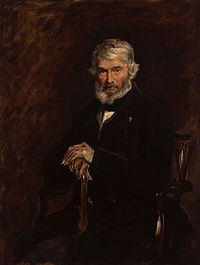 Carlyle painted by John Everett Millais. Froude wrote of this painting "under Millais's hands the old Carlyle stood again upon the canvas as I had not seen him for thirty years. The inner secret of the features had been evidently caught. There was a likeness which no sculptor, no photographer, had yet equalled or approached. Afterwards, I knew not how, it seemed to fade away."
Carlyle painted by John Everett Millais. Froude wrote of this painting "under Millais's hands the old Carlyle stood again upon the canvas as I had not seen him for thirty years. The inner secret of the features had been evidently caught. There was a likeness which no sculptor, no photographer, had yet equalled or approached. Afterwards, I knew not how, it seemed to fade away."
Thomas Carlyle is notable both for his continuation of older traditions of the Tory satirists of the 18th century in England and for forging a new tradition of Victorian era criticism of progress known as sage writing. Sartor Resartus can be seen both as an extension of the chaotic, sceptical satires of Jonathan Swift and Laurence Sterne and as an enunciation of a new point of view on values. Finding the world hollow, Carlyle's misanthropist professor-narrator discovers a need for revolution of the spirit. In one sense, this resolution is in keeping with the Romantic era's belief in revolution, individualism, and passion, but in another sense it is a nihilistic and private solution to the problems of modern life that makes no gesture of outreach to a wider community.
Later British critics and sage writers, such as Matthew Arnold, would similarly denounce the mob and the naïve claims of progress, and others, such as John Ruskin, would reject the era's incessant move toward industrial production. However, few would follow Carlyle into a narrow and solitary resolution, and even those who would come to praise heroes would not be as remorseless for the weak.
Carlyle is also important for helping to introduce German Romantic literature to Britain. Although Samuel Taylor Coleridge had also been a proponent of Schiller, Carlyle's efforts on behalf of Schiller and Goethe would bear fruit.
Carlyle also made a favourable impression on some slaveholders in the U.S. South. His conservatism and criticisms of capitalism were enthusiastically repeated by those anxious to defend slavery as an alternative to capitalism, such as George Fitzhugh.
The reputation of Carlyle's early work remained high during the 19th century, but declined in the 20th century. George Orwell called him, "a master of belittlement. Even at his emptiest sneer (as when he said that Whitman thought he was a big man because he lived in a big country) the victim does seem to shrink a little. That [-] is the power of the orator, the man of phrases and adjectives, turned to a base use." [18] His reputation in Germany was always high, because of his promotion of German thought and his biography of Frederick the Great. Friedrich Nietzsche, whose ideas are comparable to Carlyle's in some respects, was dismissive of his moralism, calling him an "insipid muddlehead" in Beyond Good and Evil and regarded him as a thinker who failed to free himself from the very petty-mindedness he professed to condemn. Carlyle's distaste for democracy and his belief in charismatic leadership was unsurprisingly appealing to Adolf Hitler, who was reading Carlyle's biography of Frederick during his last days in 1945.
This association with fascism did Carlyle's reputation no good in the post-war years, but "Sartor Resartus" has recently been recognised once more as a unique masterpiece, anticipating many major philosophical and cultural developments, from Existentialism to Postmodernism. It has also been argued that his critique of ideological formulas in "The French Revolution" provides a good account of the ways in which revolutionary cultures turn into repressive dogmatisms.
Essentially a Romantic, Carlyle attempted to reconcile Romantic affirmations of feeling and freedom with respect for historical and political fact. Many believe that he was always more attracted to the idea of heroic struggle itself, than to any specific goal for which the struggle was being made. However, Carlyle’s belief in the continued use to humanity of the Hero, or Great Man, is stated succinctly at the end of his admirably positive aforementioned essay on Mohammed, in 1841’s ‘On Heroes, Hero Worship & the Heroic in History’, in which he concludes that: “the Great Man was always as lightning out of Heaven; the rest of men waited for him like fuel, and then they too would flame.”
Works
- (1829) Signs of the Times The Victorian Web
- (1831) Sartor Resartus Project Gutenberg
- (1837) The French Revolution: A History Project Gutenberg
- (1840) Chartism Google Books
- (1841) On Heroes and Hero Worship and the Heroic in History Project Gutenberg
- (1843) Past and Present Project Gutenberg
- (1845) Oliver Cromwell's letters and speeches, with elucidations, ed. Thomas Carlyle, 3 vol. (1845, often reprinted). online version another online version
- Morrill, John. "Textualizing and Contextualizing Cromwell." Historical Journal 1990 33(3): 629-639. ISSN 0018-246X Fulltext online at Jstor. Examines the Abbott and Carlyle edit
- (1849) "Occasional Discourse on the Negro Question", Fraser's Magazine (anonymous), webpage: Online text
- (1849) Reminiscences of my Irish Journey in 1849 Online text
- (1850) Latter-Day Pamphlets Project Gutenberg
- (1851) The Life Of John Sterling Project Gutenberg
- (1858) History of Friedrich II of Prussia Index to Project Gutenberg texts
- (1867) Shooting Niagara: and After Online Text
- (1875) The Early kings of Norway
Definitions
Carlyle had quite a few unusual definitions at hand, which were collected by the Nuttall Encyclopedia. Some include:
- Centre of Immensities
- an expression of Carlyle's to signify that wherever any one is, he is in touch with the whole universe of being, and is, if he knew it, as near the heart of it there as anywhere else he can be.
- Eleutheromania
- A mania or frantic zeal for freedom.
- Gigman
- Carlyle's name for a man who prides himself on, and pays all respect to, respectability. It is derived from a definition once given in a court of justice by a witness who, having described a person as respectable, was asked by the judge in the case what he meant by the word; "one that keeps a gig," was the answer. Carlyle also refers to "gigmanity" at large.
- Hallowed Fire
- an expression of Carlyle's in definition of Christianity "at its rise and spread" as sacred, and kindling what was sacred and divine in man's soul, and burning up all that was not.
- Mights And Rights
- the Carlyle doctrine that Rights are nothing till they have realised and established themselves as Mights; they are rights first only then.
- Pig-Philosophy
- the name given by Carlyle in his Latter-Day Pamphlets, in the one on Jesuitism, to the widespread philosophy of the time, which regarded the human being as a mere creature of appetite instead of a creature of God endowed with a soul, as having no nobler idea of well-being than the gratification of desire—that his only Heaven, and the reverse of it his Hell.
- Plugston of Undershot
- Carlyle's name for a "captain of industry" or member of the manufacturing class.
- Present Time
- defined by Carlyle as "the youngest born of Eternity, child and heir of all the past times, with their good and evil, and parent of all the future with new questions and significance," on the right or wrong understanding of which depend the issues of life or death to us all, the sphinx riddle given to all of us to rede as we would live and not die.
- Prinzenraub
- (the stealing of the princes), name given to an attempt, to satisfy a private grudge of his, on the part of Kunz von Kaufingen to carry off, on the night of 7 July 1455, two Saxon princes from the castle of Altenburg, in which he was defeated by apprehension at the hands of a collier named Schmidt, through whom he was handed over to justice and beheaded. See Carlyle's account of this in his "Miscellanies."
- Printed Paper
- Carlyle's satirical name for the literature of France prior to the Revolution.
- Progress of the Species Magazines
- Carlyle's name for the literature of the day which does nothing to help the progress in question, but keeps idly boasting of the fact, taking all the credit to itself, like French Poet Jean de La Fontaine's fly on the axle of the careening chariot soliloquising, "What a dust I raise!"
- Sauerteig
- (i. e. leaven), an imaginary authority alive to the "celestial infernal" fermentation that goes on in the world, who has an eye specially to the evil elements at work, and to whose opinion Carlyle frequently appeals in his condemnatory verdict on sublunary things.
- The Conflux of Eternities
- Carlyle's expressive phrase for time, as in every moment of it a centre in which all the forces to and from eternity meet and unite, so that by no past and no future can we be brought nearer to Eternity than where we at any moment of Time are; the Present Time, the youngest born of Eternity, being the child and heir of all the Past times with their good and evil, and the parent of all the Future. By the import of which (see Matt. xvi. 27), it is accordingly the first and most sacred duty of every successive age, and especially the leaders of it, to know and lay to heart as the only link by which Eternity lays hold of it, and it of Eternity.
Notes
- ^ a b c d e f g h i j k l m n o p "Thomas Carlyle" (bio), Dumfries-and-Galloway, 2008, webpage: dumfries-and-galloway.co.uk-carlyle.
- ^ a b "Carlyle--The Sage Of Chelsea". English Literature For Boys And Girls. Farlex Free Library. http://marshall.thefreelibrary.com/English-Literature-For-Boys-And-Girls/82-1. Retrieved 2009-09-19.
- ^ Carlyle Till Marriage 1795 to 1826 by David Alec Wilson, 1923. Available on Google Books here, page 42-43. "As a 'double-goer', perplexing strangers in foreign parts as well as at home, the 'Apostle' was occasionally an innocent, inadvertent nuisance to 'our Tom'."
- ^ a b Lundin, Leigh (2009-09-20). "Thomas Carlyle". Professional Works. Criminal Brief. http://www.criminalbrief.com/?p=8890. Retrieved 2009-09-20.
- ^ a b "Who2 Biography: Thomas Carlyle, Writer / Historian". Answers.com. 2009. http://www.answers.com/topic/thomas-carlyle. Retrieved 2009-09-19.
- ^ Cumming, Mark : The Carlyle encyclopedia : 2004 : ISBN 978-0-8386-3792-0 p223
- ^
 "Heroes and Hero-worship". Encyclopedia Americana. 1920.
"Heroes and Hero-worship". Encyclopedia Americana. 1920. - ^ Carlyle, Thomas (1869). On heroes, Hero-Worship, & the Heroic in History. London: Chapman and Hall, 301.
- ^ "Reviews from the Neue Rheinische Zeitung Politish-Ökonomische Revue No. 4" contained in the Collected Works of Karl Marx and Frederick Engels: Volume 10 (International Publishers: New York, 1978) pp. 301-310.
- ^ "Reviews from the Neue Rheinisch Zeitung Politisch-Ökonomische Revue No. 4" contained in the Collected Works of Karl Marx and Frederick Engels: Volume 10, p. 306.
- ^ From http://www.fromoldbooks.org/Wood-NuttallEncyclopaedia/e/everlastingyea.html where they cite it as coming from The Nuttall Encyclopædia, edited by the Reverend James Wood (1907)
- ^
 "Frederick the Great". Encyclopedia Americana. 1920.
"Frederick the Great". Encyclopedia Americana. 1920. - ^
 "Carlyle, Thomas". Encyclopedia Americana. 1920.
"Carlyle, Thomas". Encyclopedia Americana. 1920. - ^ Simon Heffer, Moral Desperado - A Life of Thomas Carlyle, Weidenfeld & Nicolson, 1995, p.48
- ^ http://www.pakistanlink.com/Opinion/2006/Jan06/06/04.HTM "East Did Meet West - 3", by Dr. Rizwana Rahim
- ^ Samuel Butler (Nov. 21, 1884), Letters Between Samuel Butler and E.M.A. Savage 1871-1885 (1935)
- ^ [1],
- ^ Orwell, Review of the Two Carlyles by Osbert Burdett, The Adelphi March 1931
Bibliography
- Alice Chandler. "Carlyle and the Medievalism of the North." In: Medievalism in the Modern World. Essays in Honour of Leslie J. Workman. Ed. Richard Utz and Tom Shippey (Turnhout: Brepols, 1998). pp. 173–91.
- A. A. Ikeler. Puritan Temper and Transcendental Faith. Carlyle's Literary Vision (Columbus, OH: 1972).
- Hugh A. MacDougall. Racial Myth in English History: Trojans, Teutons, and Anglo-Saxons (Montreal: Harvest House and UP of New England, 1982).
- F. W. Roe. The Social Philosophy of Carlyle and Ruskin (Port Washington, NY: 1978).
- W. Waring. Thomas Carlyle (Boston, MA: 1978).
See also
- Annales School and New History
- Carlyle's House in Chelsea, London
- Craigenputtock in Dumfriesshire
- Great man theory
- Max Weber's charismatic authority
- Philosophy of history
- On Heroes, Hero-Worship, and The Heroic in History
- Übermensch
- Whig history
- Famous Scots Series
- Historiography of the French Revolution
External links
- Works by Thomas Carlyle at Project Gutenberg (plain text and HTML)
- Thomas & Jane Carlyle's Craigenputtock the official site
- Works by Thomas Carlyle at Internet Archive (original edition scanned books)
- Thomas Carlyle: An Overview at The Victorian Web
- Thomas Carlyle: A Quick Introduction
- Thomas Carlyle: Biography by John Nichol, via Project Gutenberg
- Poems by Thomas Carlyle at PoetryFoundation.org
- The Life and Death of Thomas Carlyle @ Ward's Book of Days
- The Carlyle Letters Online
- Famous quotes by Thomas Carlyle
- Archival material relating to Thomas Carlyle listed at the UK National Register of Archives
- A guide to the Thomas Carlyle Collection at the Beinecke Rare Book and Manuscript Library
- Anonymous (1873). Cartoon portraits and biographical sketches of men of the day. Illustrated by Frederick Waddy. London: Tinsley Brothers. pp. 114–115. http://en.wikisource.org/wiki/Cartoon_portraits_and_biographical_sketches_of_men_of_the_day/Thomas_Carlyle. Retrieved 2011-03-13.
Academic offices Preceded by
William Ewart GladstoneRector of the University of Edinburgh
1865–1868Succeeded by
The Lord MoncreiffCategories:- 1795 births
- 1881 deaths
- Rectors of the University of Edinburgh
- Thomas Carlyle
- Scottish essayists
- Scottish mathematicians
- Scottish philosophers
- Scottish historians
- Scottish literary critics
- Scottish satirists
- Scottish translators
- Existentialists
- People associated with Transcendentalism
- Historians of the French Revolution
- Alumni of the University of Edinburgh
- People from Dumfries and Galloway
- National Portrait Gallery, London
- Recipients of the Pour le Mérite (civil class)
- Romanticism
- People of the Victorian era
- 19th-century philosophy
- Defenders of slavery
- People educated at Annan Academy
Wikimedia Foundation. 2010.



